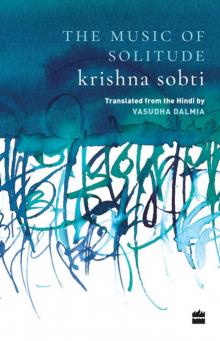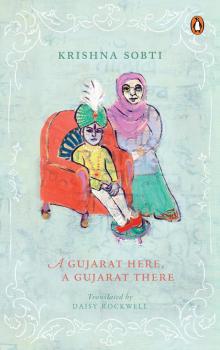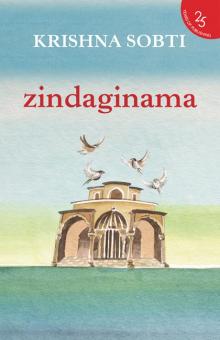- Home
- Krishna Sobti
Zindaginama
Zindaginama Read online
KRISHNA SOBTI
Translated from the Hindi by
Neer Kanwal Mani
with
Moyna Mazumdar
NEW YORK • LONDON • TORONTO • SYDNEY • NEW DELHI
One fateful morning, I woke up with echoes of azaan in my ears, and before my eyes stood one minaret of the village mosque. I knew instinctively that I was committed to carry the powerful internal echo of this voice through the century.
While writing Zindaginama, I tried to focus on a precise visual and dramatic recall of peasant speech. The simple use of the visible and the audible created a world of its own. All I wanted was to paint the surge of humanity – their strong rustic faces, their noise. Yes, I had to create their speech – rough, potent, verbal – with the help of their spoken words and diction.
– Krishna Sobti
Indicative map of undivided Punjab as described in Zindaginama
CONTENTS
Translators’ Note
The Living Tree
Zindaginama
Glossary and Notes
About the Book
About the Authors
Praise for Zindaginama
Copyright
TRANSLATORS’ NOTE
Zindaginama is Krishna Sobti’s magnum opus, a giant patchwork tapestry in rich warm colours and vivid detail, that depicts the life and times of a small village in pre-Partition Punjab – a Punjab that once spread across the five divisions of Rawalpindi, Multan, Lahore, Jalandhar and Ambala. That world, that way of life, no longer exists, neither in India, nor in Pakistan. Much has changed in the last hundred years – the schism that ripped through the land as final as a Tectonic-shift – yet the past, beautifully evoked in this book, sparks the depths of our collective memory, hearkening back to a bond that predates the bitter events of recent history and puts the focus on a kinship that our souls intuitively thrill to and instinctively recognize. As it were, providing sources, completing fragments, giving body, words, rhythm and music to distantly recollected but oddly familiar snatches of some song.
Zindaginama was originally conceived of as a trilogy chronicling the life and times of the people of Punjab before, during and after the partition of India. The first part, comprising this volume, was called Zinda Rukh, The Living Tree and published in 1979. The latter two parts were never written, but the blueprint for the original trilogy has been outlined in the prologue, written in poetic form. It describes a land blessed with plenty, a land of doughty men and women, who gave true fight to the British, wrested Independence from them, and yet, sadly, acquiesced to Partition. The prologue describes the majestic geography of the land, a proud people, their customs, cares and celebrations, their passionate relationship with their land and rivers, and finally the winds of change sweeping across the country and reaching this golden land, disturbing the calm, but also awakening it. The story of the village is the story of the nation.
It is sometime in the first decade of the twentieth century. The British have been in power for over 150 years. However, life in Shahpur, Gujrat, has remained largely peaceful. All village affairs are led by the Shahs, the worldly-wise older brother, Shahji and his benevolent and devout younger sibling, Kashi Shah. The Shah Brothers are landowners and moneylenders and are at the helm of village politics and decision-making. Their frequent visits to Lahore and nearby cities keep them in touch with local, regional, national and international politics. The evening gatherings at the Shah haveli see an exchange and discussion of daily happenings. The newspaper from Lahore, an important source of information and opinion that helps to shape the village’s responses and reactions to the national and international events is read out, and many of the village elders contribute to the ensuing analyses and discussions. More and more men from the village are enlisting in the British army. They talk eagerly of British bounty, and then, of its excesses. From them the village learns of the revolutionaries fighting for India’s independence. As a national consciousness slowly begins to develop so does an awareness among the lower-castes of the injustices by their own people against them.
The village women are led by the older Shah’s pious and dutiful wife, Shahni. Her home is the focus of all celebrations and rituals. Weddings, betrothals, infidelities, children, romances, scandals, second wives, mothers-in-law, recipes, antidotes and small rivalries are all discussed here. The deepest confidences are fearlessly exchanged in her kitchen, around her hearth. Visiting Pirs and Fakirs, oracles, poets and soothsayers are all accorded much respect. Haunted by her inability to have a child, Shahni worships all gods. But sometimes goodness is not enough. The soulful voice and serene, simple beauty of Rabeyan and her mesmeric Sufi poetry has charmed everyone. Brought into the Shah household to care for and play with Shahni’s newly begot son, Lali Shah, Rabeyan’s unspoken yet intense longing for Shahji poises the narrative on razor’s edge.
The Shah haveli, its evening gatherings, and kitchen politics serve as a barometer of the change that is taking place in the country, and the world at large. Shahpur is a microcosm, a self-contained universe, in which the drama of human existence is played out in all its depth and sweep; the closely detailed personal histories of a wide set of characters and their interactions with the rest are each precisely and exquisitely defined by their class, caste, age, local customs and traditions. The language of exchange is also determined by the private and the public realm, education and the wider connotations of national and international politics. Each character is imbued with a voice and a temperament to match his or her unique private and public situation. Thus they each enrich the text with their peculiar idioms and signature abuses, their superstitions and robust humour, their coarseness, their profundity, their music and their wit, making the novel resound with the vitality of diverse voices in different dialects and registers.
Interspersed with beautiful verses and prayers from Classical languages like Persian and Sanskrit as well as Sufi poetry, Zindaginama is epic in scale and imagination. A winner of the Sahitya Academy Award, it is a landmark in Indian literature.
Zindaginama has been an engaging text in terms of translation strategies. All our energies have been focused on bringing the flavour and richness of life in the Gujrat Punjab of the first two decades of the twentieth century to the reader. The gradual shift from innocence to a consciousness of the political changes sweeping across the country; and the gradual awakening of a people to a new social order, form the movement of the text, in both the private and the public realm.
The text is polyphonic, and is mostly in form of conversations. The following decisions mark this translation.
1. Pronunciation:
Attention has been paid to how the words sound as well as read on the page. Punjabi as a language has a natural bounce, rhythm and a swing of its own, in keeping with the nature and temperament of its people.
Thus Bebe, which means ‘mother’ is also used to address a revered old lady of the village, would have acquired English connotation if it had been written as bebey.
2. Forms of address: prefixes and suffixes
In Punjabi, people usually begin a sentence with an expletive, interjection or an emotional burst, and a ji is added as a mark of respect if the elders are present. This ji is retained to convey the flavour of the conversation. Same way, Badshaho (O Kings) is used to show respect to the gathering. Other interjections used and retained in the translation are Malla (Well now!), Kyon (Why) Bas (Enough), pronounced as Bus, Phitte Moonh, pronounced as Phittey Moonh, meaning shame on your tongue; Ri, used to address a girl or a woman of a younger age or of a lower status; and Re (pronounced as Ray) and Oye, used to address a boy or a man of a younger age or of a lower status. Vadde (elder) is to be pronounced as Vaddey.
Form of address changes according t
o the context of exchange or relationship or the emotional mood. Thus Najiba, while being addressed may become Najibeya, Fatta may become Fatte (pronounced as Fattey) or Fatteya in an informal exchange. Mabibi being called out may be called as Mabibiye, Lakkhami may be addressed as Lakkhmiye, both ending with the sound ay.
3. Retaining specific terms and expressions of the source culture
Punjabi, Urdu, Persian and Hindi terms and phrases have been retained in places where they lend a specific flavour or nuance to the situation or utterance. As much as possible, their meaning, close as possible, has been conveyed through the context. This has also been done in places which showcase Sobti’s style, word- play or her turn of phrase. Thus terms such as maya-moh, taqdeer and tadbeer have been retained to convey the cultural nuances as well as how the text sounds in original.
4. Translation of verses
One of the most remarkable features of Zindaginama is how verses of all kinds and flavours are integral to the text: there is Sufi poetry, Waris Shah’s Heer in Punjabi, Bulle Shah’s kafis and other verses in Punjabi and Urdu, Shah Latif’s verses in Sindhi, Vishnusahastranam and Shlokas in Sanskrit, songs for each occasion and ditties and rhymes in local dialect.
Each verse has been translated keeping the meaning, the flavour, the occasion and the stylistic convention intact, so far as possible. But the clarity of the meaning has been retained if the style could not be.
We are grateful to Nandita Aggarwal who has lifted this translation so much closer to Krishna Sobti’s professed richness and variety of language. This translation has greatly benefitted from her formidable skills both as a participant as well as an editor, and her meticulous working out of details and nuances has helped us in putting forward this translation with a sense of confidence.
THE LIVING TREE
The stature
Not of pen
Nor writer
Nor writing, either.
Life spread
On sheets of paper
By itself
On its own
Like a tree risen from earth
With roots that go deep down
A gigantic living tree
History that is not
And history that is
Not the one
Recorded in chronicles
With proofs and evidence
Of might
Of dispensations
And their glorious reign
But the one
That flows
Along the sacred Bhagirathi
Of people’s consciousness;
Flourishes
Spreads
And stays alive
In the vital resilience
Of ordinary people.
ZINDAGINAMA
Like arms thrown around shoulders,
Rising, teasing.
Like milk-heavy breasts
This land of Chenab and Jhelum
Like a mother
Unlacing her kurta
Cascading milk.
Glinting on heaps of wheat
The sweet sunshine
Of early morn.
Fleeting, sweet
Cool breezes caress
Snowy peaks adorned
With silver chowkphool ornaments,
Rippling
Mustard-yellow fields,
Galloping across
Fortune-favoured Chenab’s
Frisky, amazing waters,
Whose drops of nectar
Grew trees of blood
Along boundaries of green.
On determined brows, on arrogant foreheads,
On proud moustaches, on wheat-coloured skin
On impressive, solid countenances–
The divine redness of wheat.
Clinking their bangles,
Radiant as fields of corn,
Sherbet-eyed
New brides,
Laughing and teasing,
Capturing hearts,
These passionate Heers
Of open, abundant Punjab
Standing in a downpour of sun
Stealing sidelong glances
From behind Phulkari veils
At their proud men
Arraigned resolute as gods,
On the boundaries of their fields.
So
Vibrant Punjab’s
Milk-rich homes.
On colourful peedhies sit the queens
Spinning skeins
Of finest cotton.
Fulsome, voluptuous,
Draped in thick khadi silk
The maharanis of toil.
Bending over glowing tandoors,
The godly aroma
Of ghee-soaked,
Thick, heavy rotis.
Touching their hands
To the dough
Awakening
Fanning
Enflaming
Life’s fragrance.
In star-glow,
In the still-dark,
Yoking his oxen to the plough,
The custodian of each field
Under wide-open skies
Grew golden crops
For centuries.
Always.
The youth of each generation
Each morning
Unshackling from slumber
His sleep-sweetened body
Paid homage to his land
On whose sustained hard work
Mothers, sisters, girlfriends
Cheerily renounced pots of nectar;
Let it flow.
This picture remained etched of manly Punjab.
The warrior temperament,
The mishri-sweet water.
In beating hearts,
In arms eager for battle,
In frolicsome rivers.
Dressed in green,
Preening, shocking
Bedecked, bride-like,
The soil of Punjab.
One’s eyes lifted
A thousand times,
The skies bent
A thousand times.
Time and again.
Fragrant motia flowers adorned
The bridegroom’s sehra
A million times.
The drums of Baisakhi and Lohri rolled
A million times.
Feet kept the beat
Of the bhangra and gidda.
Seeds grew
And mounds of golden harvest
Were piled everywhere.
In their bosoms
Mothers nurtured
The saplings of doughty
Daughters and sons
By propitiating sages, fakirs,
And with their reckless, doting love.
Whose flesh and bones were then tempered
By the biting cold
And blazing summer winds,
By goading and stoking
Their aggressive
Combative nature.
Suckling
Their warrior sons and daughters,
These brave-speaking women
Resplendent in their gold kanthas
And lakha rani-haars.
Under the laden beri trees
Lisping, chirping children played
Gulli-danda and saunchi
From dawn to dusk,
Leaping and catching
By turn.
In courtyards and bedrooms
Shimmering, auspicious raiments,
Baag and phulkari.
Granaries filled with maize and millet
Scenting each home
Within and without.
This prosperous land’s
Glowing prosperity
Gleamed in every eye,
Celebrating the sanctity
Of every hearth.
Pouring fist on fist,
Into vessels and pots.
To clothe and eat and enjoy
To heart’s desire.
Where every
Self-respecting, hard-working badshah
Che
rished his turban
Like a crown,
And deeming his fields his fortune,
Bowed to them.
But torrents of poison
Closed in on
This favoured and flourishing
Land of Punjab;
All at once
The multitudes descended.
The assaults were innumerable
So too confrontations
With the enemy.
Dispensations changed
Many a time
But the broad-chested
And brave-hearted
Stood dauntless,
Never fearing to kill
Or be killed.
But today …?
Do the brave play
By a new set of rules?
Their weapons hang limp,
Their shoulders slump,
Their hands cannot bear
The weight of weapons.
Where is the surging anger of those who stood
Ready to fight
At the first call to arms?
Like a godly decree,
Are these decisions also
Irrevocable?
Turn your face
From home and hearth,
From the greenness
And your bejewelled crops.
Turn your back
On the green
The ripened grain
The azure skies.
We have exhausted
Our reservoir of good deeds
On this soil.
Now we have to part from our land,
Our mother,
Our mother’s mother,
And the mother of us all!
Out of her sweet shelter
And her shade.
Now her milk-laden breasts
Drip not milk
But blood.
Look back.
Don’t look back.
Run.
Leave behind
This water
This soil
That produced sapling warriors
Every spring, every season,
That infused the bones and flesh of men
With a zeal for work
And a zest for life,
Lighting flames
Igniting passion.
Farewell to the pride of waters
To five-rivered Punjab
To Jhelum and Chenab.
Farewell
To the memory of our ancestors
Whose children
Of milk and blood
Will never again play
In this dust

 The Music of Solitude
The Music of Solitude A Gujarat Here, a Gujarat There
A Gujarat Here, a Gujarat There Zindaginama
Zindaginama